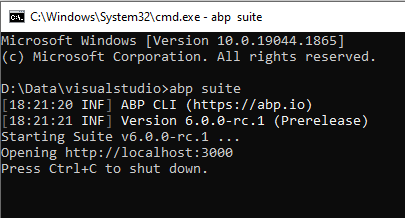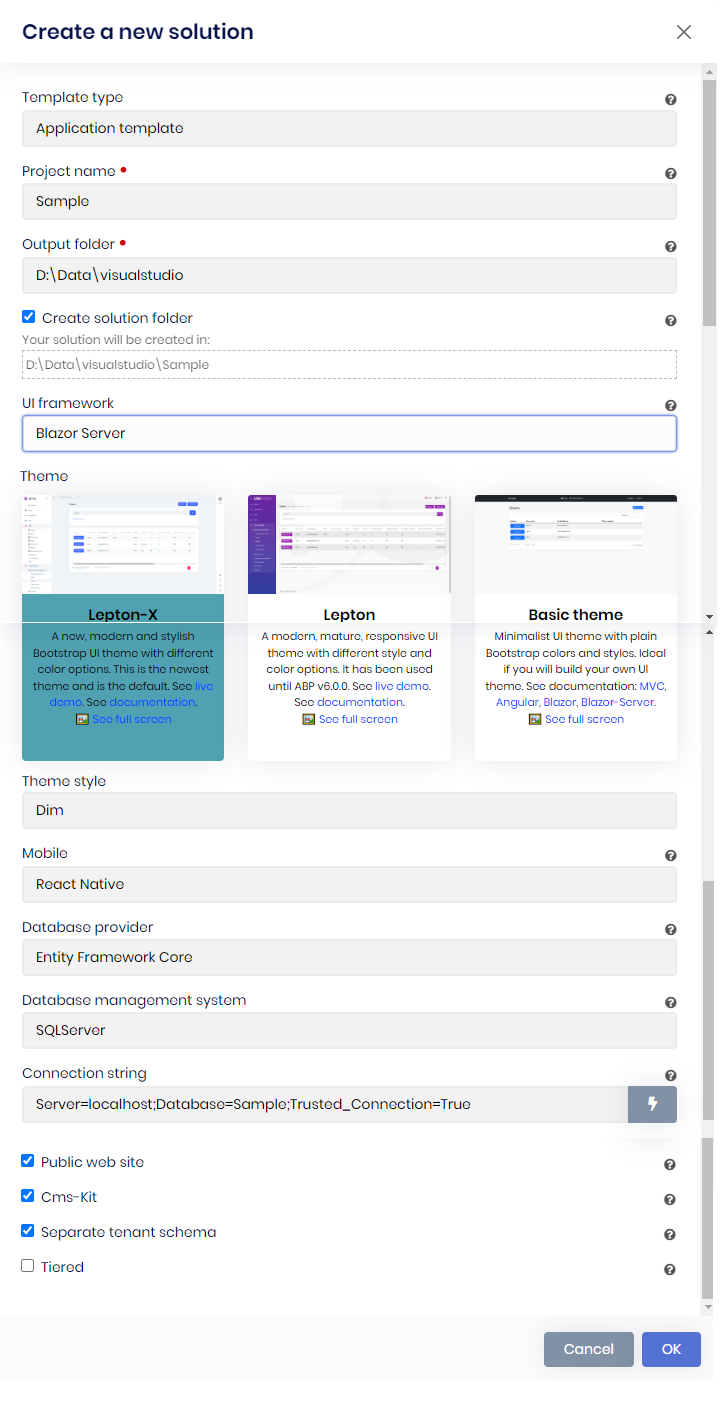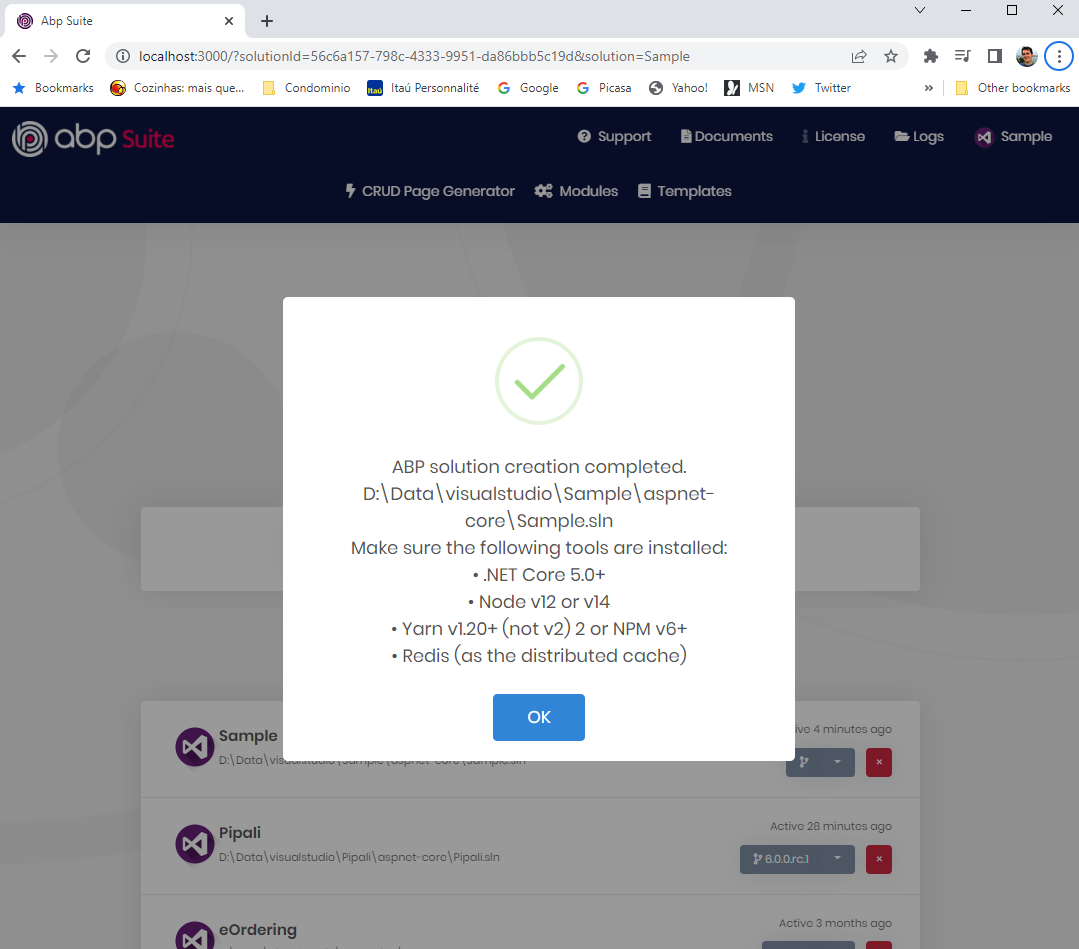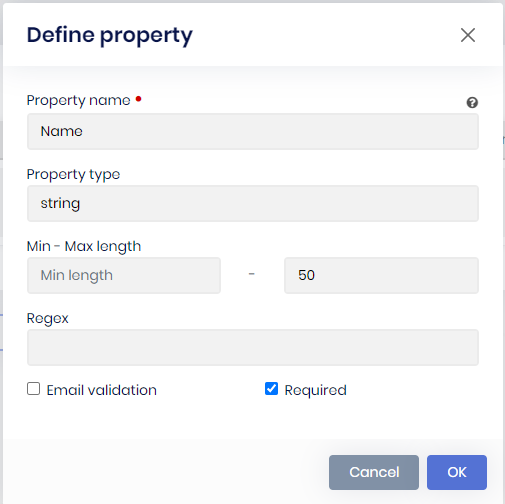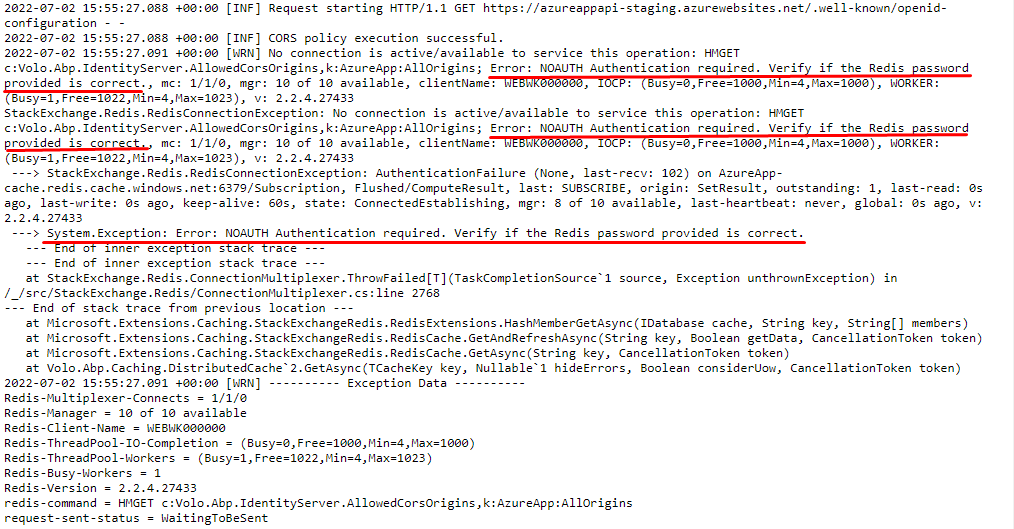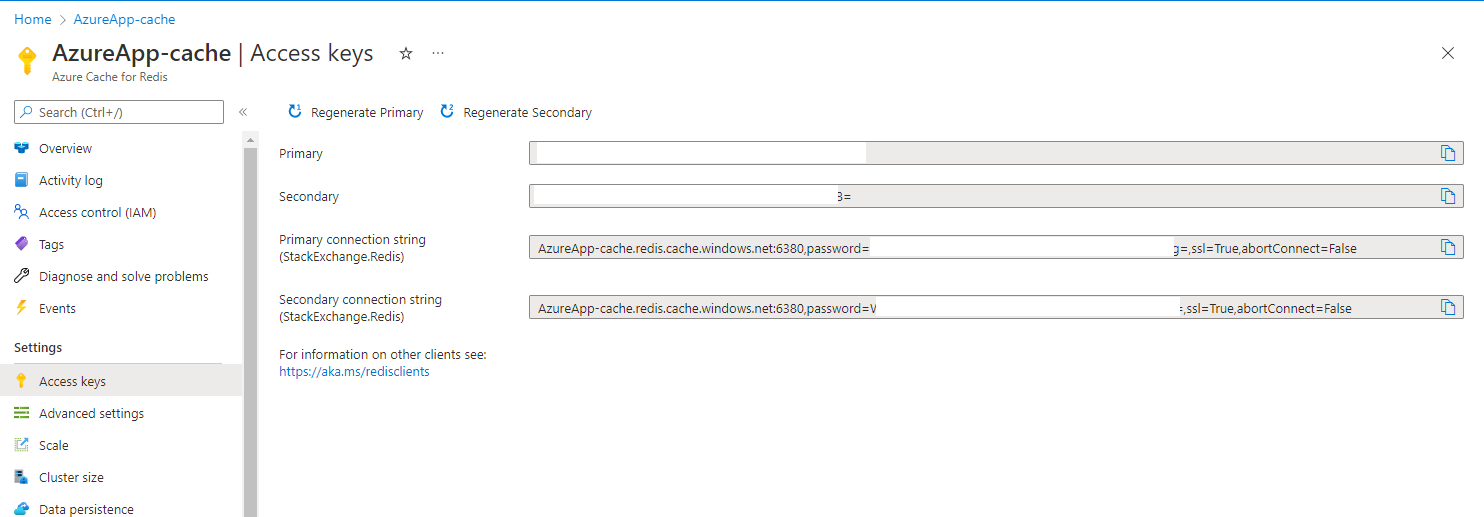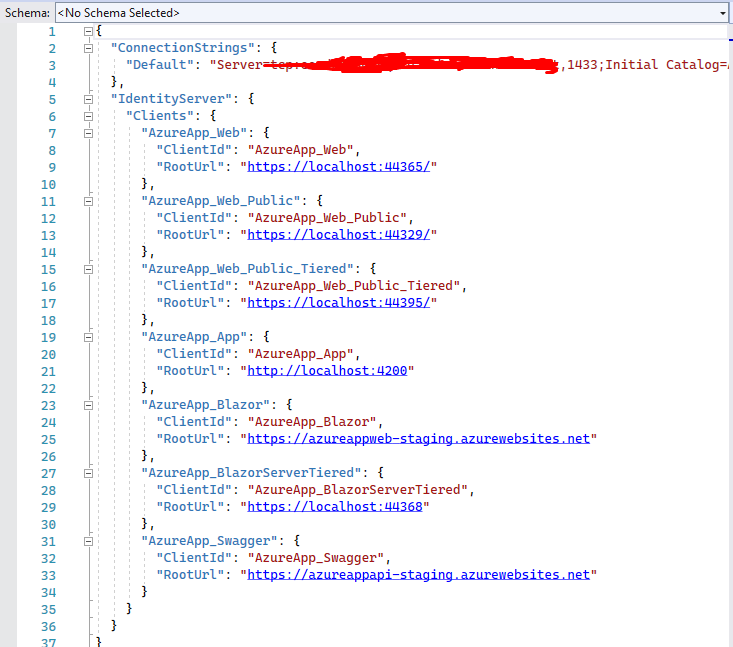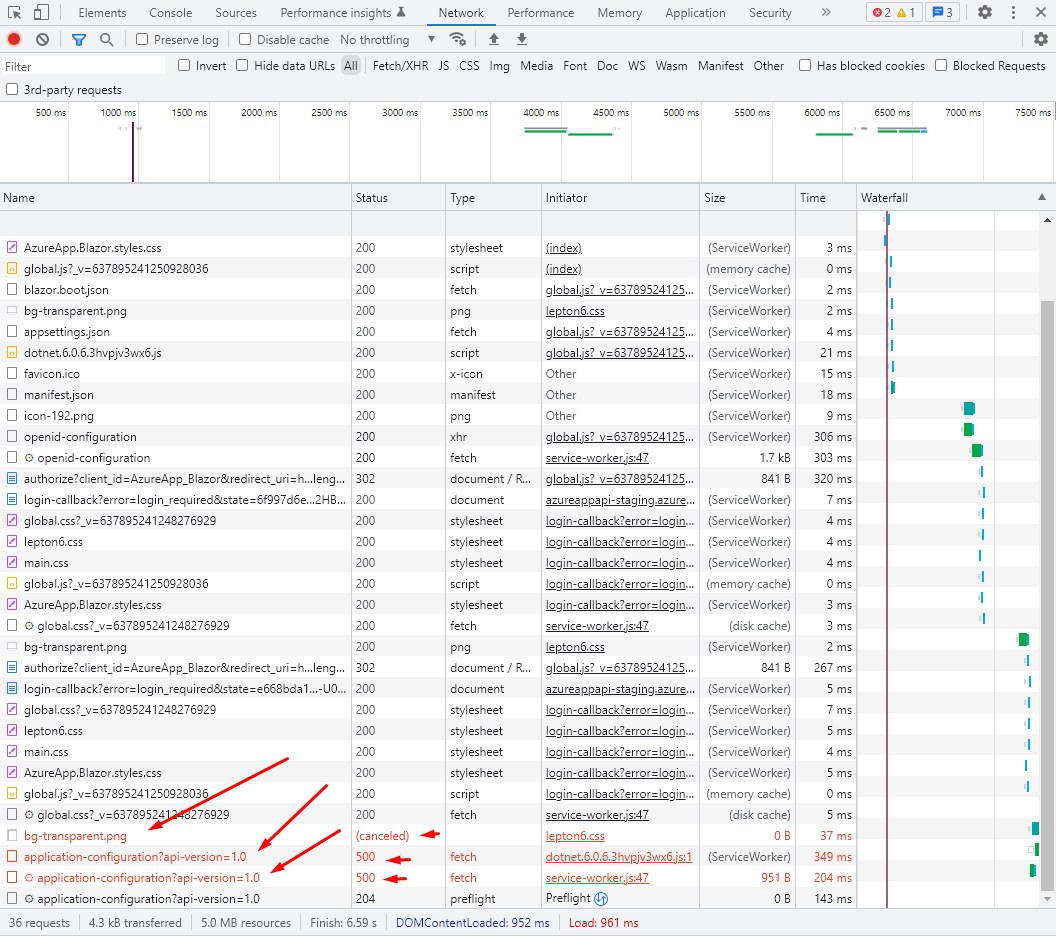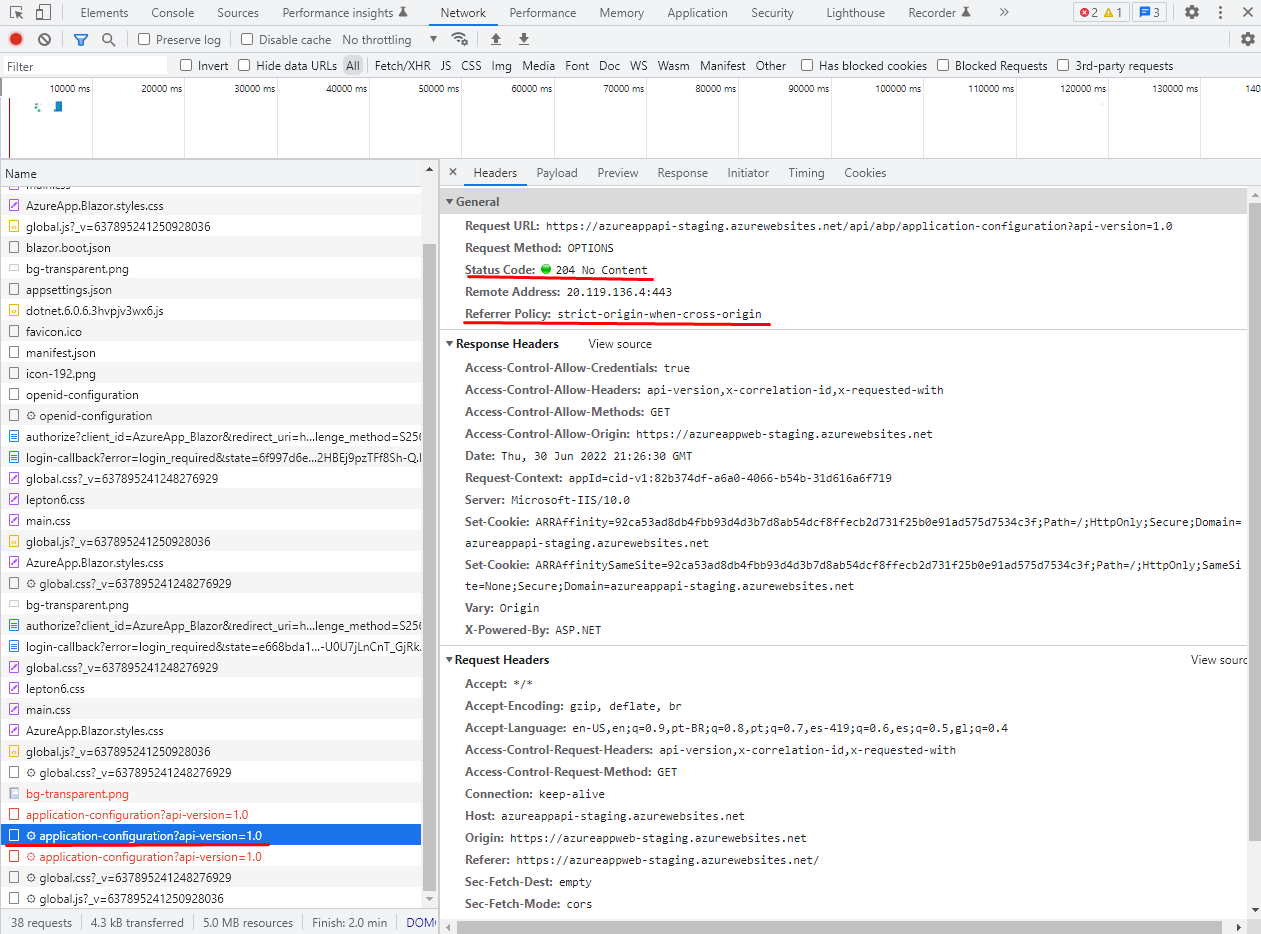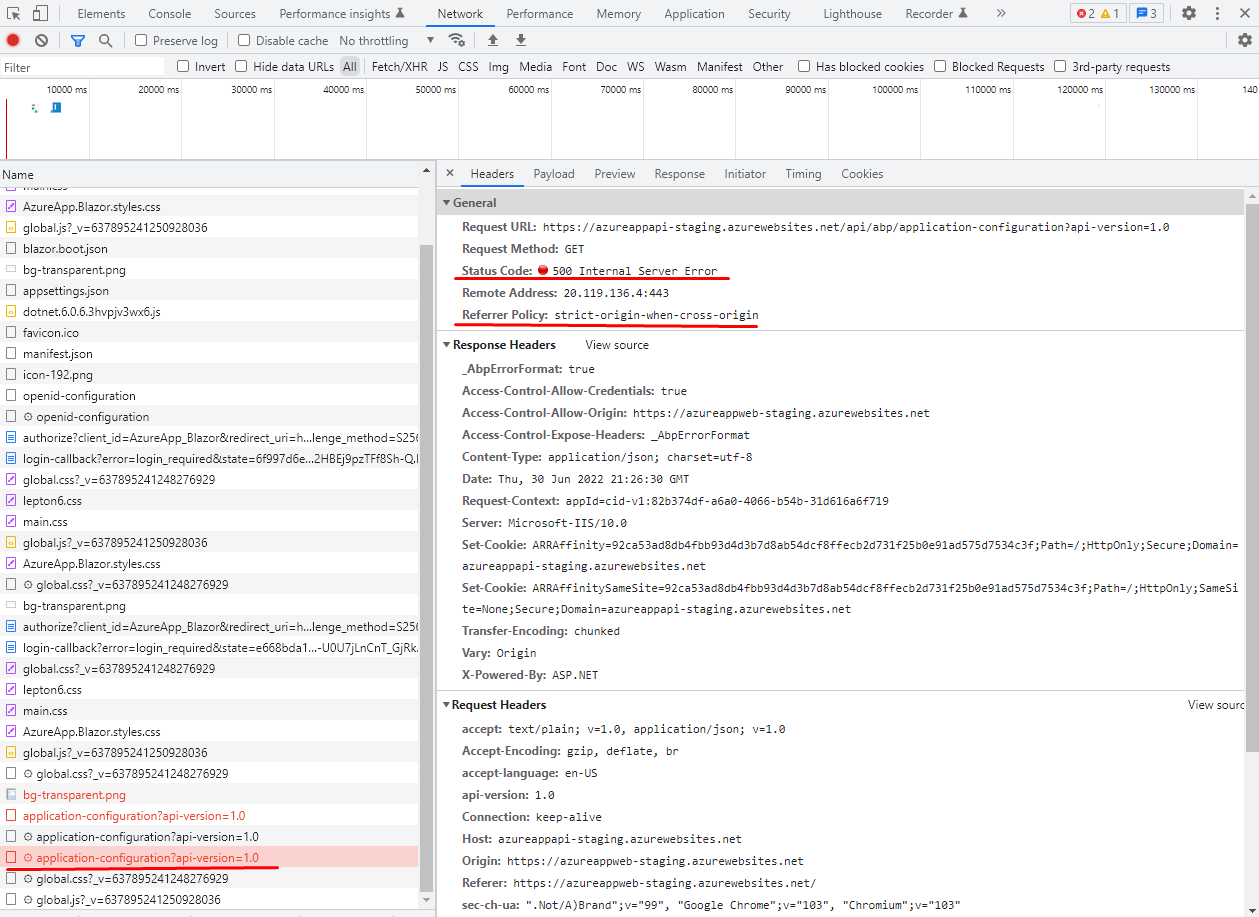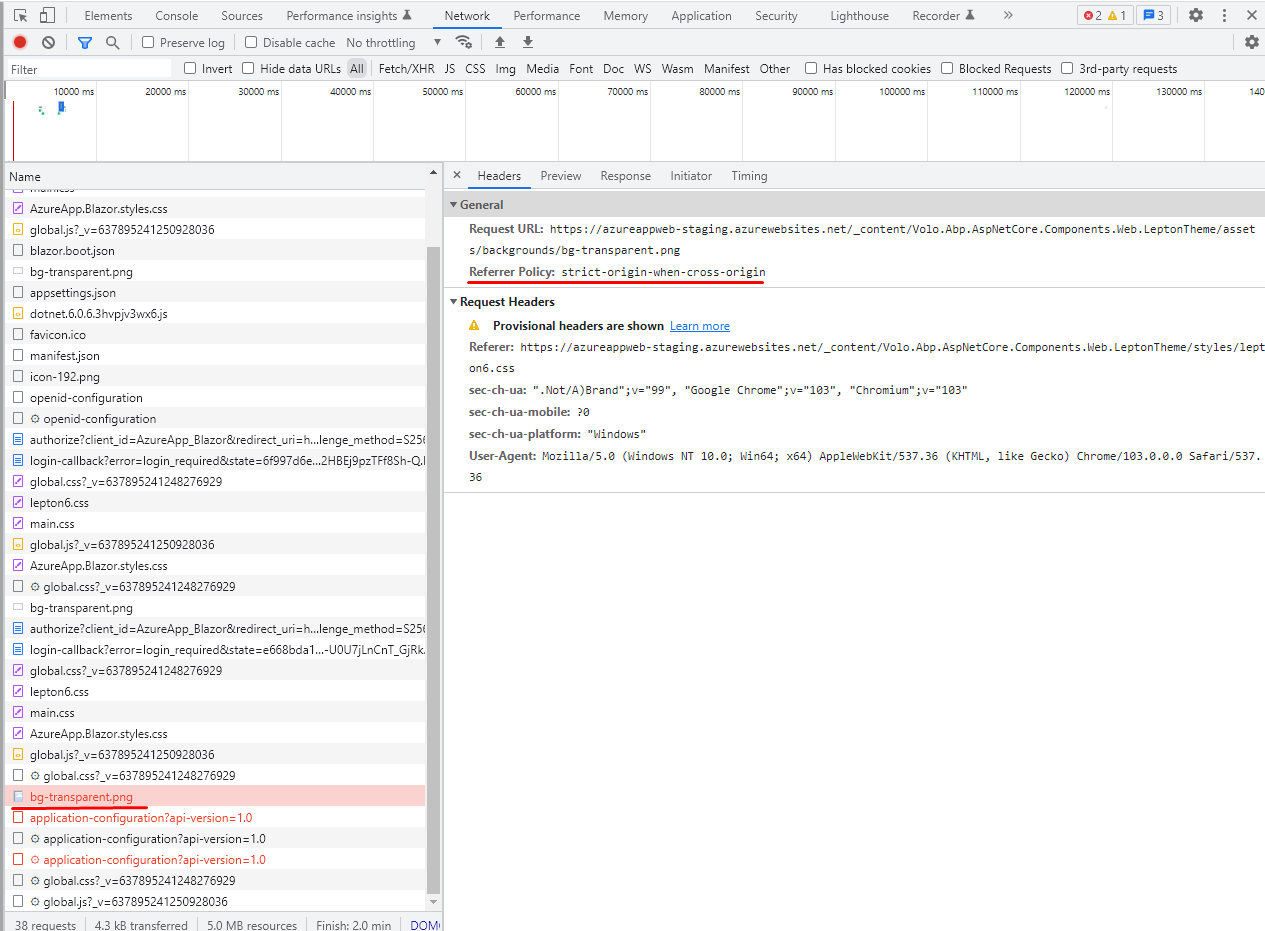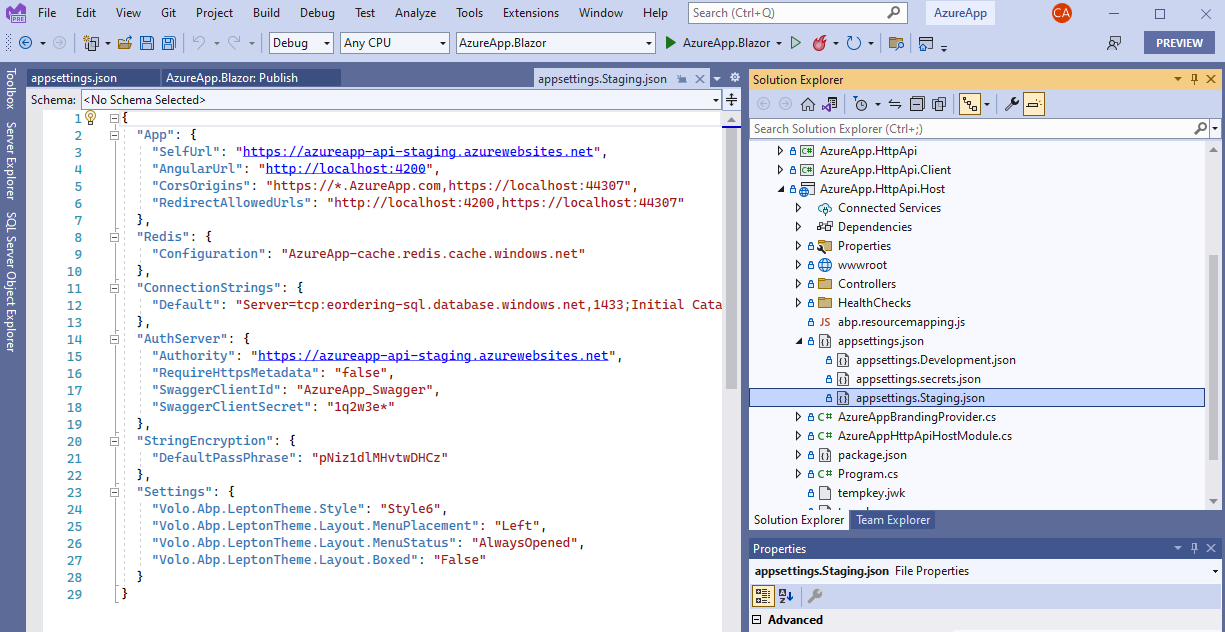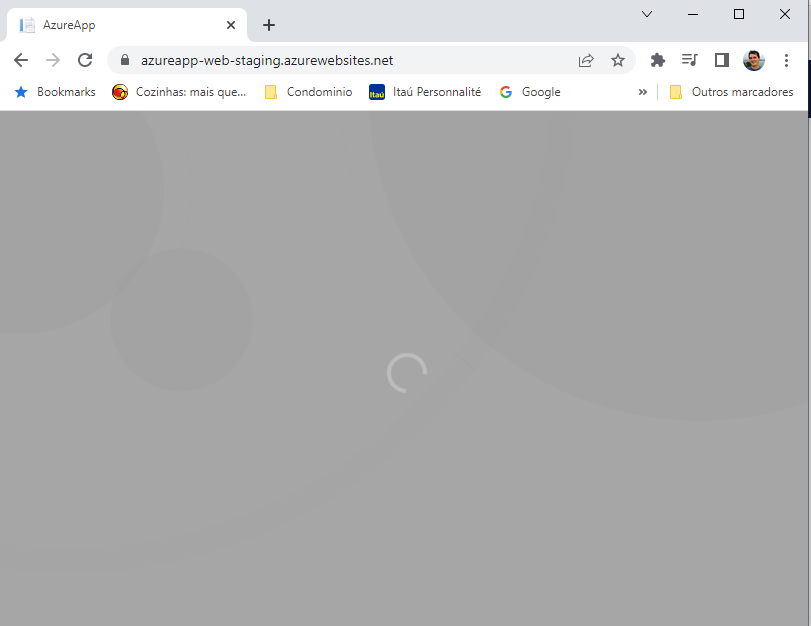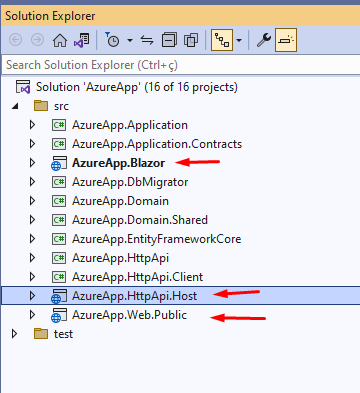Activities of "chrisalves"
Check the docs before asking a question: https://docs.abp.io/en/commercial/latest/ Check the samples, to see the basic tasks: https://docs.abp.io/en/commercial/latest/samples/index The exact solution to your question may have been answered before, please use the search on the homepage.
If you're creating a bug/problem report, please include followings:
- ABP Framework version: 6.0.0-rc.1 (Prerelease)
- UI type: Blazor Server
- DB provider: EF Core
- Tiered (MVC) or Identity Server Separated (Angular): no
- Exception message and stack trace:
- Steps to reproduce the issue:
I updated the ABP and ABP suite to 6.0.0-rc.1 (Prerelease) today and tried to create a sample application to discover the new features announced on 6.0.0-rc.1 (Prerelease).
I just launched ABP Suite, and selected the following fields to create the application and figured out that the applicantion does not run in my local computer. I believe that something is missing in the SUITE when creating the solution. The stable version (5.3.3) works very well, but the prerelease is failing)
Here below is the outputs from ABP suite command line screen.

Here is the Wizard asking for initial build and seed
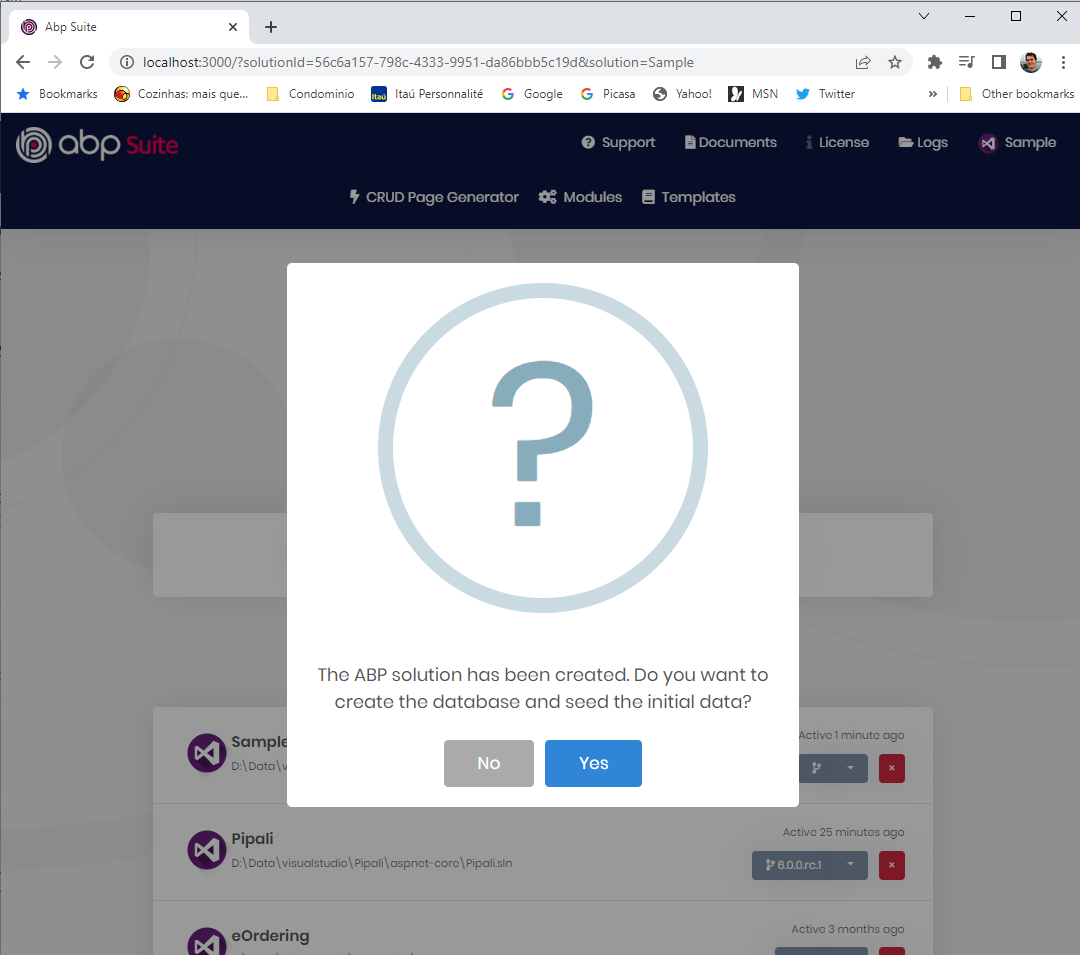
After this, I´ve tried to run the application using Visual Studio, but after the browser launches the application, nothing is shown in the browser, many alerts appears in the Visual Studio outputs, and many error messages appear in the Server side.
Here is the initial step to build and run the sample application
Multiples warnings on Visual Studio presented below:
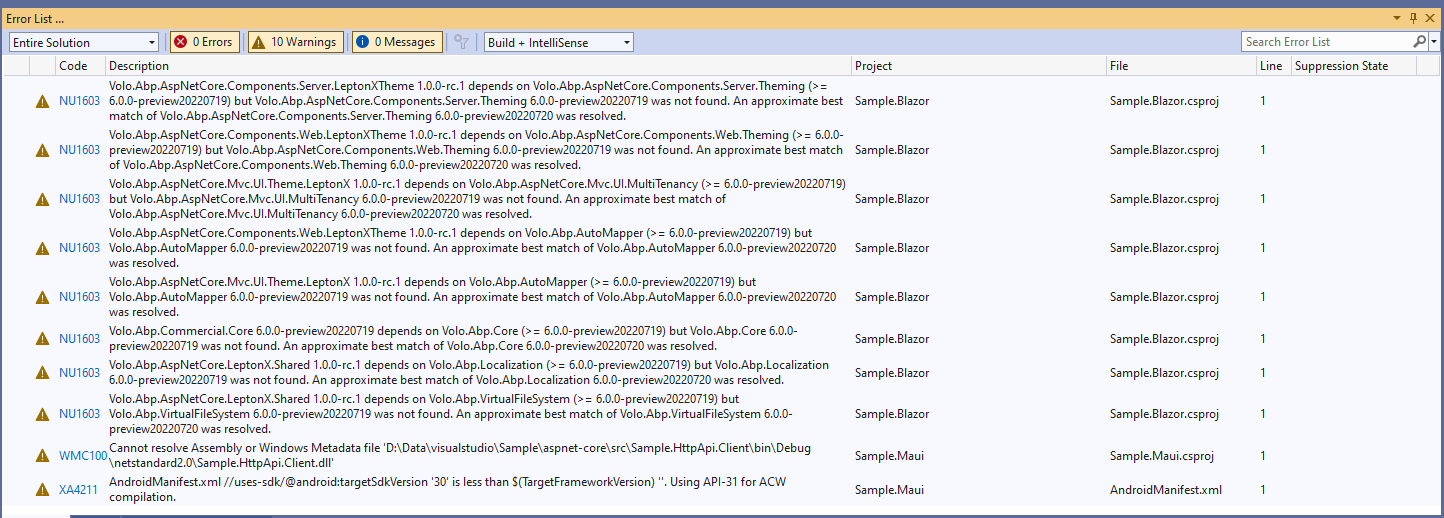
The building output has warnings:
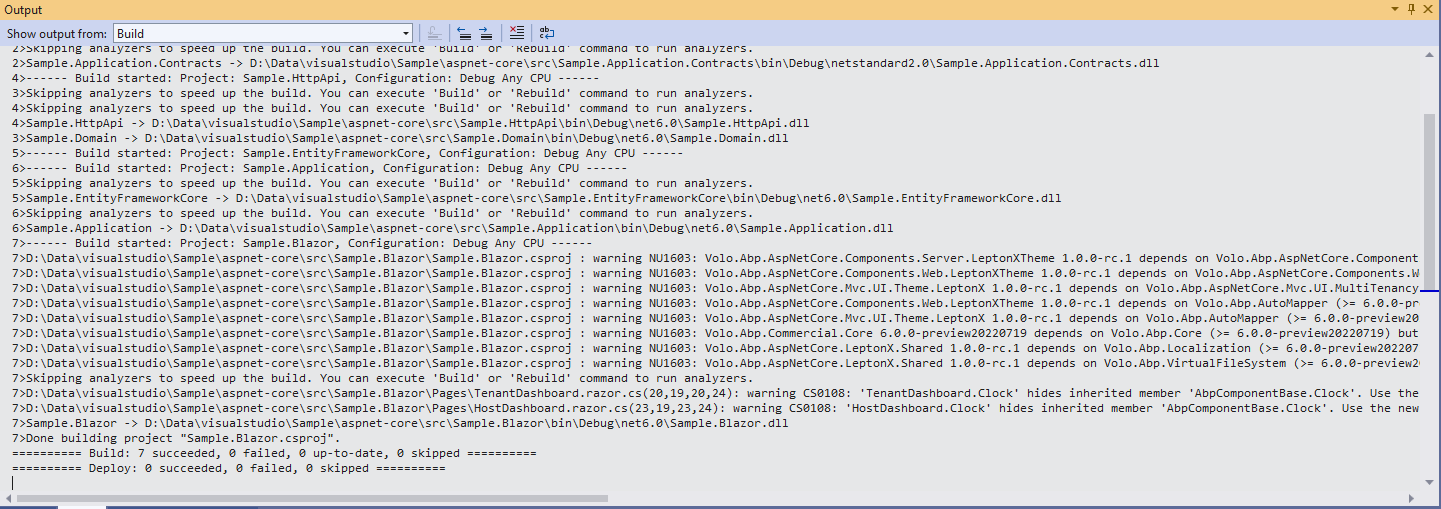
<br>
Additionally, the appsettings.json does not contain the Authentication Server or remote server:
There are many errors in the Console of DEV Tools of Chrome:
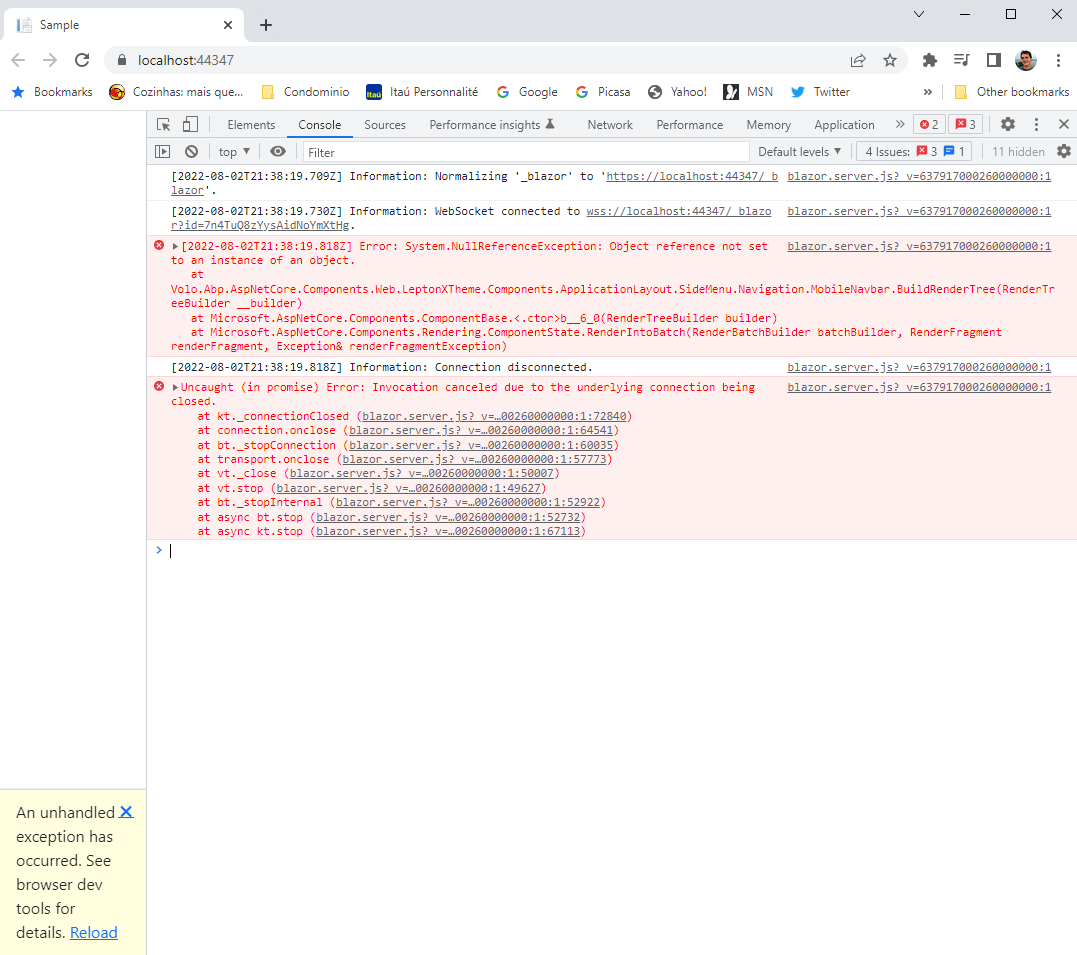
Please, help.
hi
I tried to replace the Redis Cache "Configuration" in the appsettings.json with the AzureApp-Cache connection string but after this, the Swagger doesn´t load and gets error. I´ve tried to add only the password after the Redis Server separeted by Comma, but it also did not work.
Please share the related error logs.
Hi Maliming, Thanks for your return. Here is the new log, containing data from today (July 6th, 2022): https://sasdsupport.blob.core.windows.net/serverlogs/azureappapi-staging-logs-2022-07-06.txt
I´ve made some tentatives to solve. I updated the solution files to ABP Commercial 5.3.1 including all packages using the ABP Suite feature as you can see in the CLI outputs:
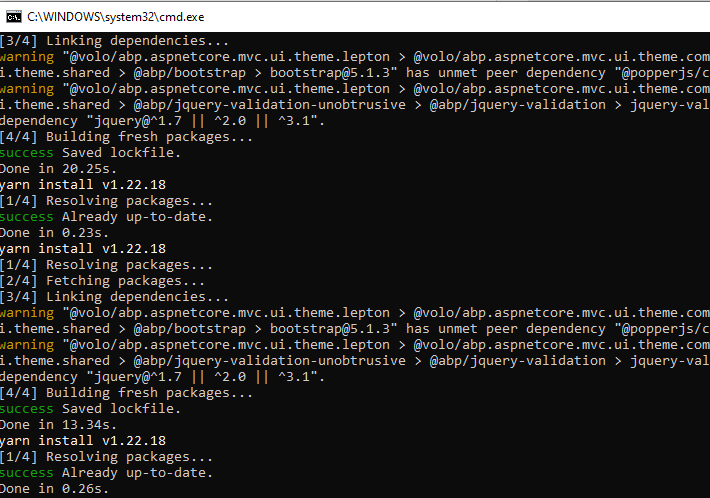
After this, I build the entire solution using Visual Studio 2022.
After this I updated the Redis Configuration in file appsettings.json as presented in the picture below.

I´m not sure what is the root cause, I believe it could be the version of ABP. Now the Application is working.
Hi Maliming, I reported an error about the ABP tool created with ABP Suite, using the ABP default process, and it is not working on the remote servers. Someone in the Support side requested to submit the Log to investigate what can be the error. You are sending an Article from Microsoft and I do not understand the why you are sending this article for me, because the Azure Cache is configured correctly. The problem is certainly related to the configuration of ABP application side, and there is not information on how to configure the application to run correctly with the Azure Redis Cache. Please send to this ticket the step by step process to make configure the Redis Cache, what shoud be done in the ABP Commercial/framework, to allow the applicatioin works correctly.
Thanks,
Christian
using Microsoft.AspNetCore.Extensions.DependencyInjection
Thanks. I added this "Using" and now it is building correctly.
Thanks
Check the docs before asking a question: https://docs.abp.io/en/commercial/latest/ Check the samples, to see the basic tasks: https://docs.abp.io/en/commercial/latest/samples/index The exact solution to your question may have been answered before, please use the search on the homepage.
If you're creating a bug/problem report, please include followings:
- ABP Framework version: v5.3.1
- UI type: Blazor WebAssembly PWA
- DB provider: EF Core
- Tiered (MVC) or Identity Server Separated (Angular): No / no
- Exception message and stack trace:
- Steps to reproduce the issue:
- Create a New Solution using ABP Suite as the picture below. The feature "Public Web Site" is not selected. This is causing the application do not run.
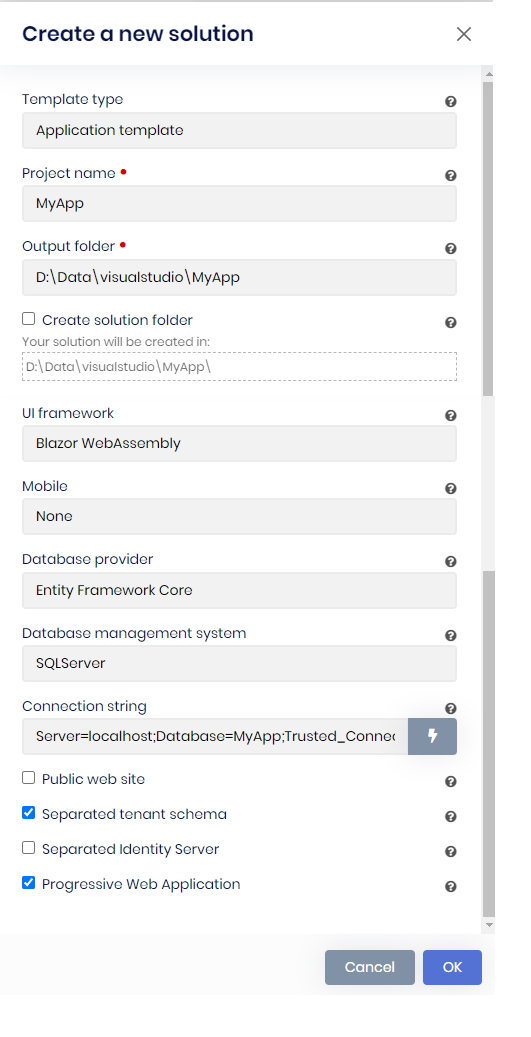
- ABP Suite creates the new application
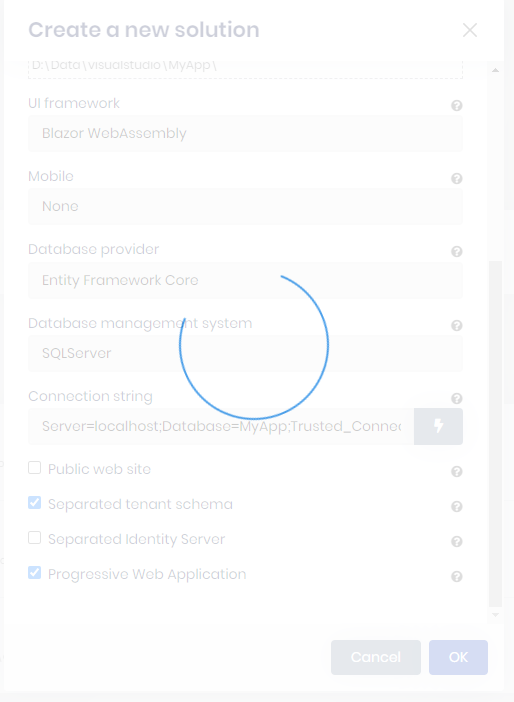
- Seed the Initial Data
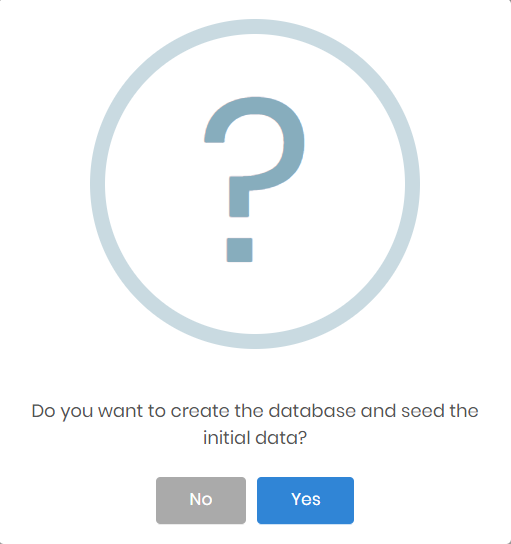
- ABP executing the Initial Seed in the created database and builds the application
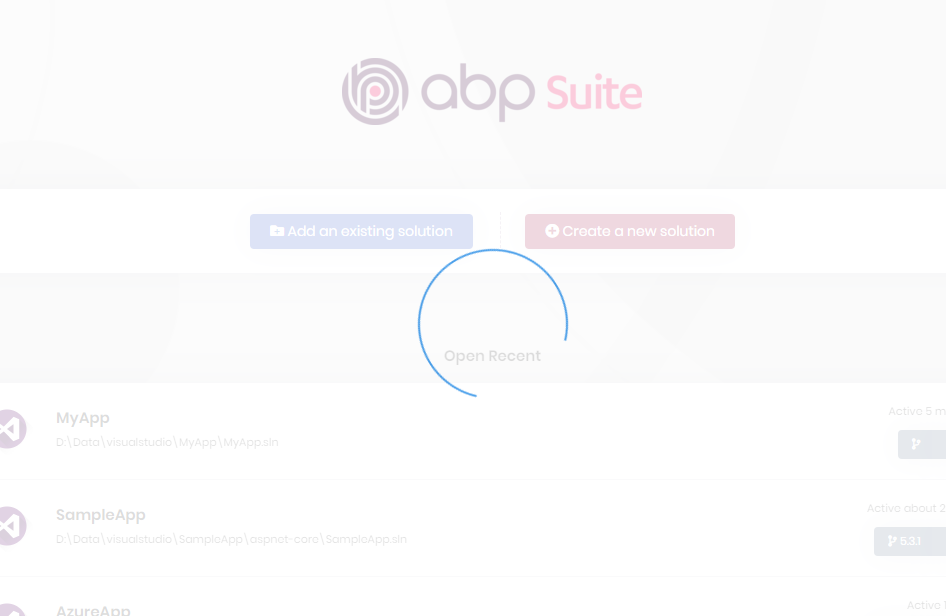
- The application is created with success according to the Popup
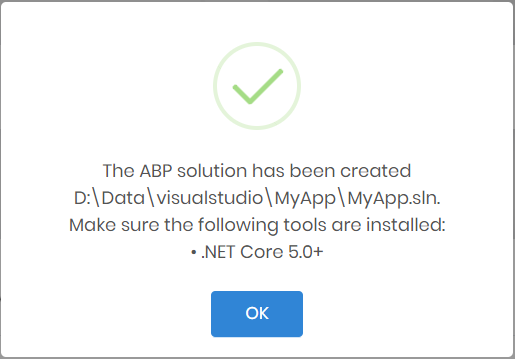
- Create a simple Entity like "Customer" and add a simple property like "Name" with 50 of max size and required as pictures below:
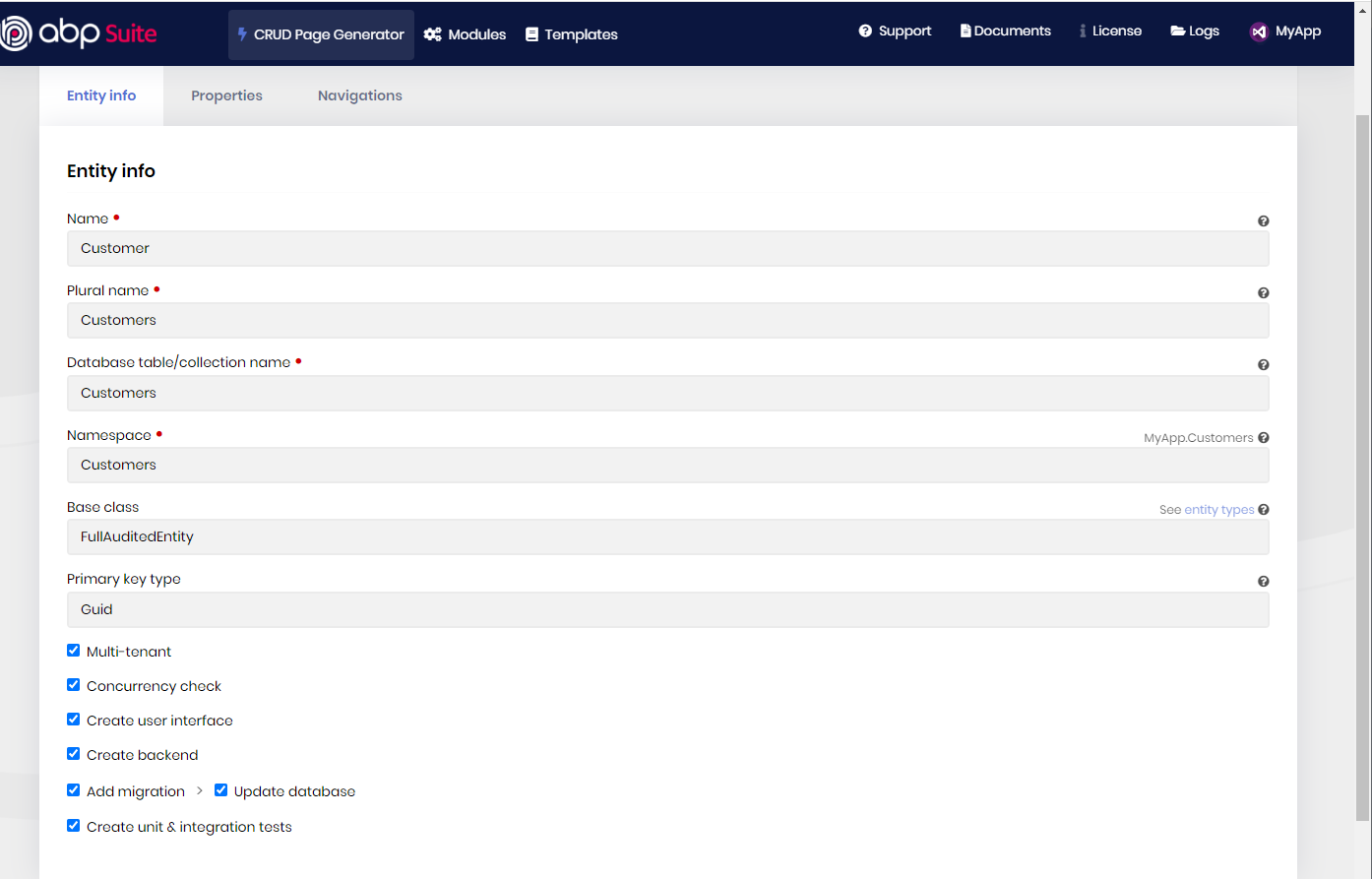 (Entity)
(Entity)
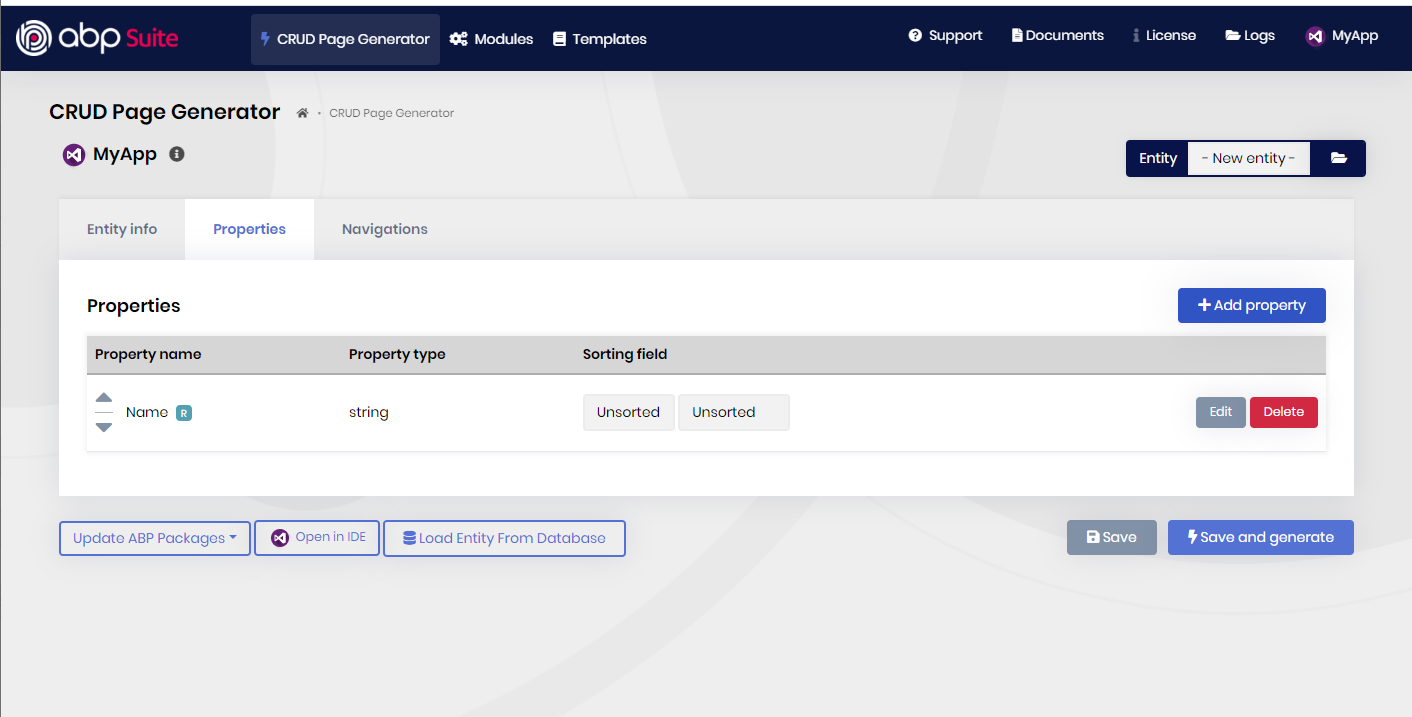 7. Hit the buton "Save and generate".
7. Hit the buton "Save and generate".
- Select the buton "Yes"
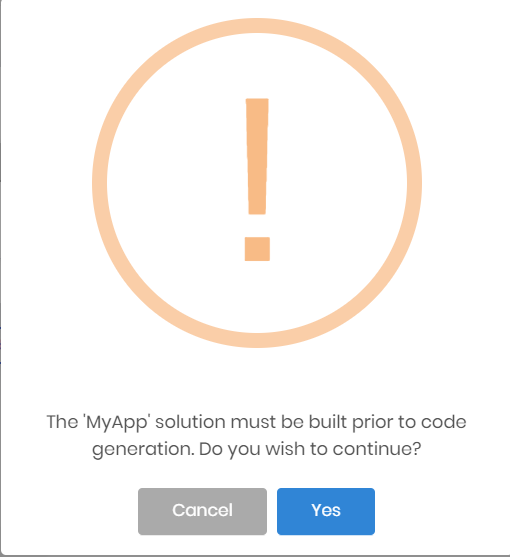
- The application is being built
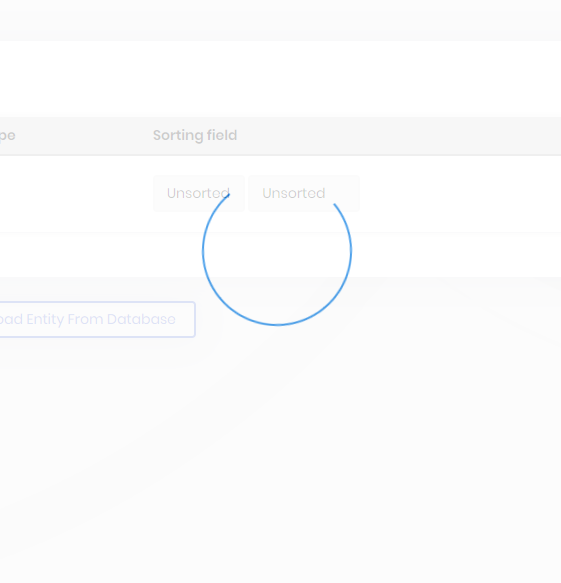
- You will see an error at the end of this process.
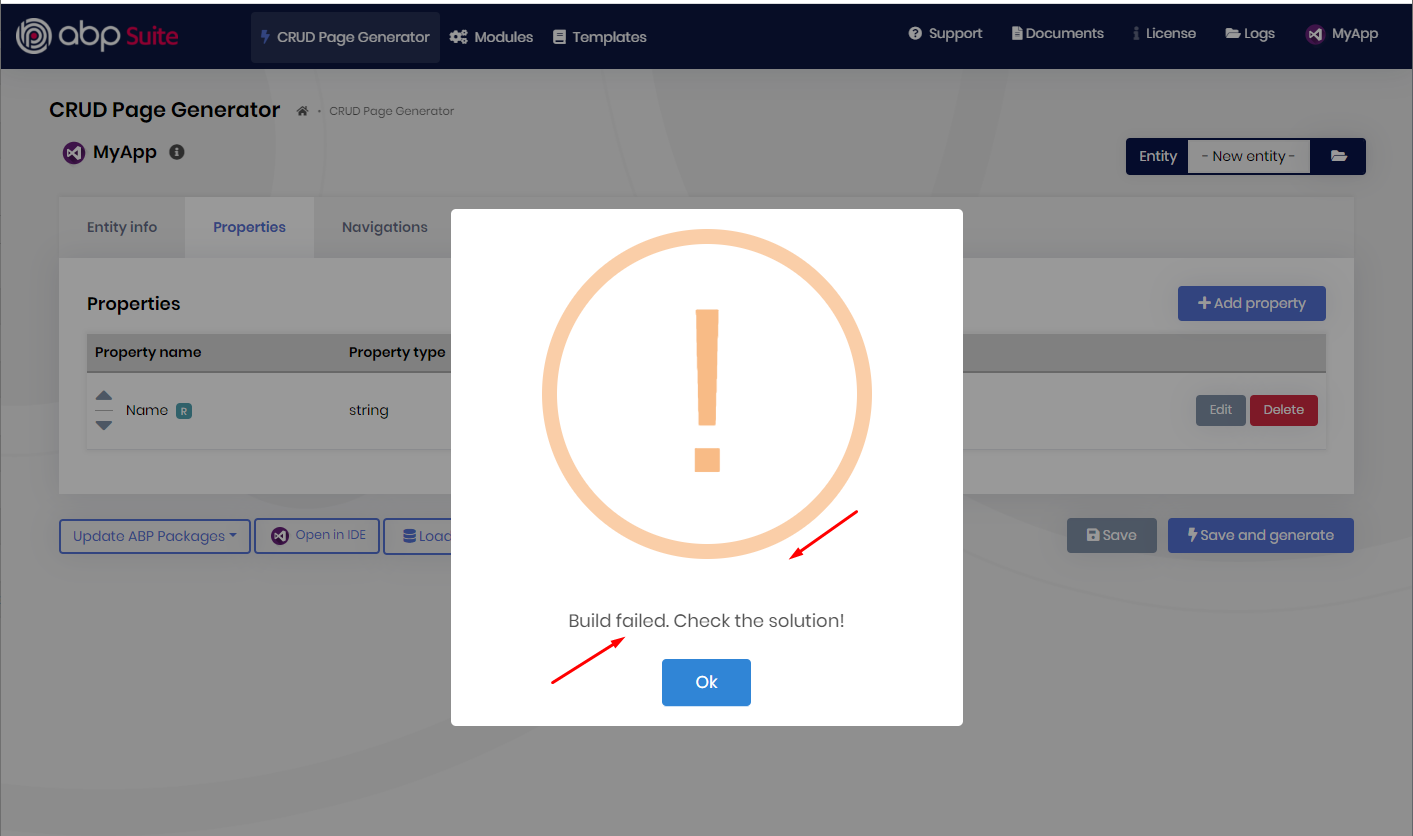
- The Database was created with success
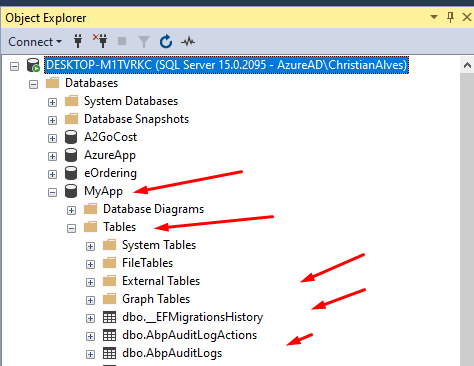
- Try to build and RUN the HttpApi.Host manually using Visual Studio 2022 (same used for other projects), selecting this project and using CRTL+F5
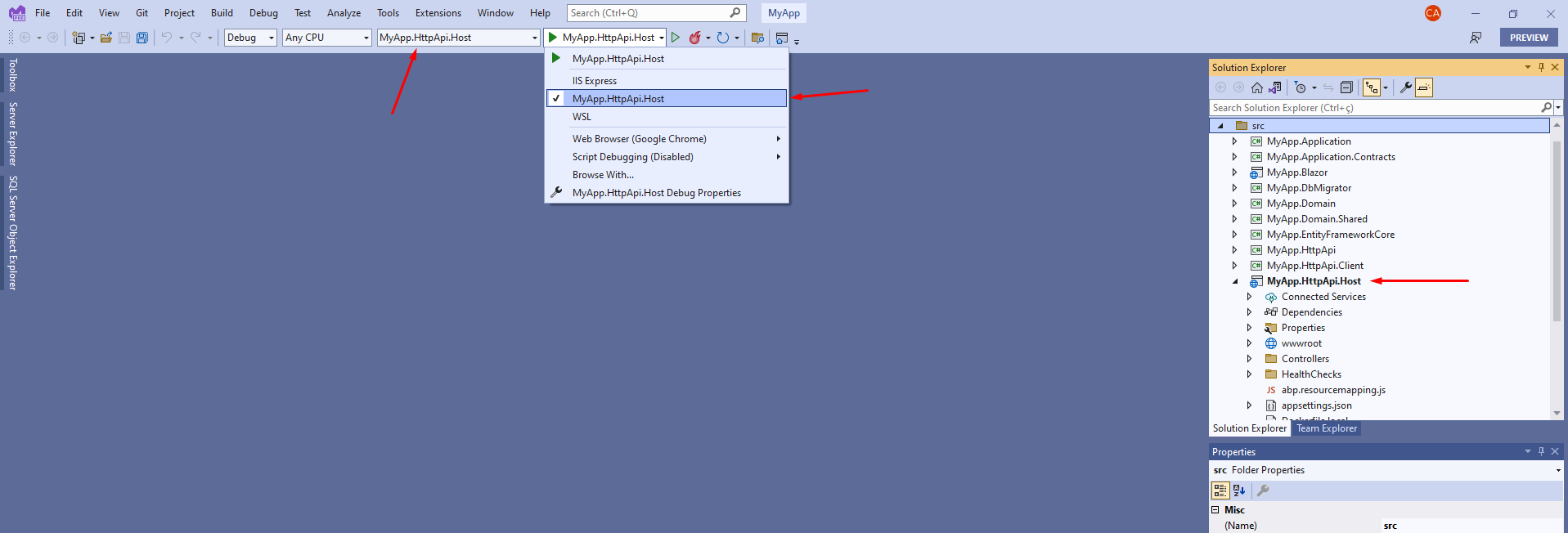
- See the error presented by Visual Studio during the Build process.
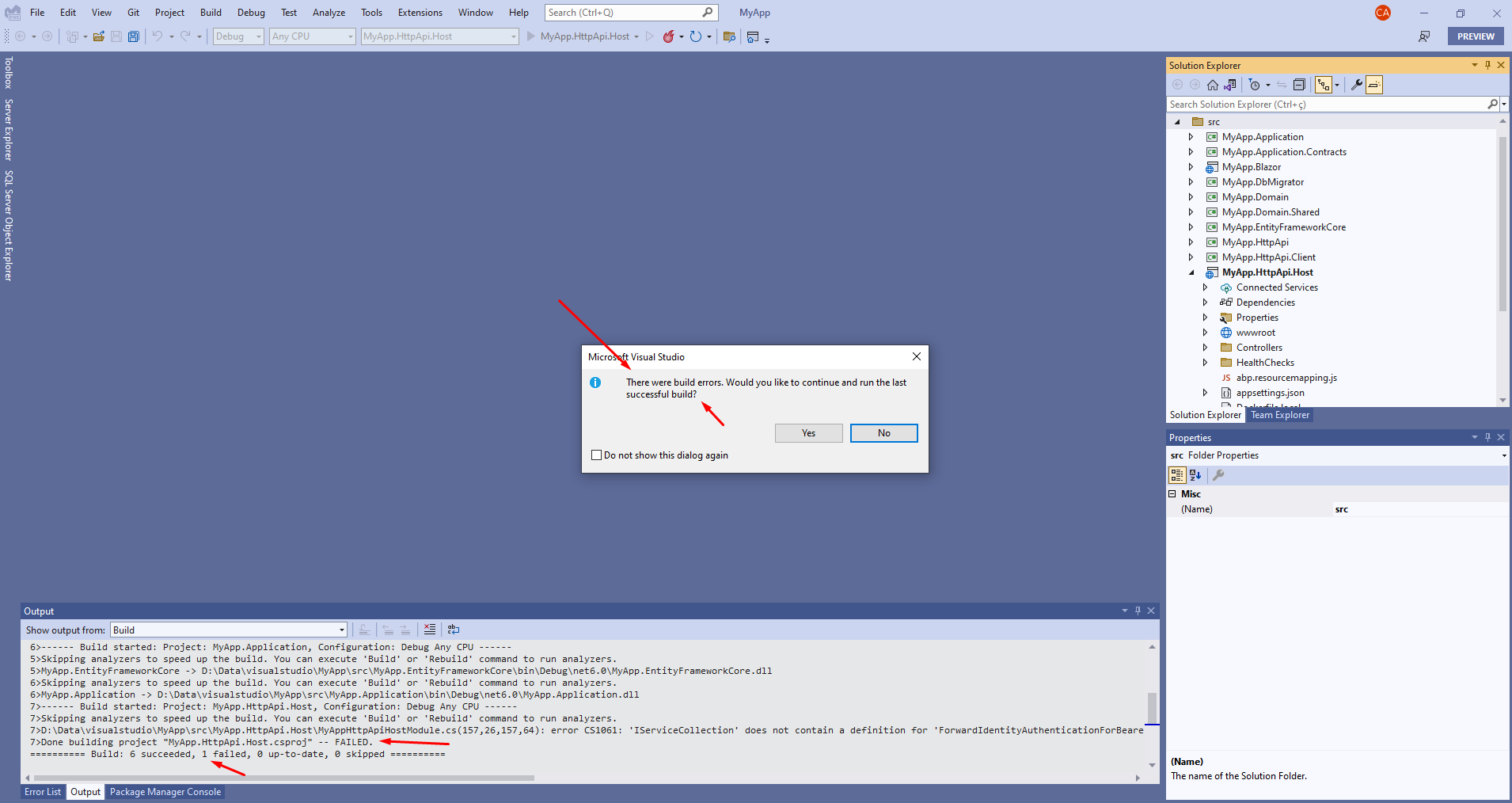
- Read the Error description after this process

Severity Code Description Project File Line Suppression State Error CS1061 'IServiceCollection' does not contain a definition for 'ForwardIdentityAuthenticationForBearer' and no accessible extension method 'ForwardIdentityAuthenticationForBearer' accepting a first argument of type 'IServiceCollection' could be found (are you missing a using directive or an assembly reference?) MyApp.HttpApi.Host D:\Data\visualstudio\MyApp\src\MyApp.HttpApi.Host\MyAppHttpApiHostModule.cs 157 Active
I´ve tried to create this app many times, without success. ABP Suite only works fine if the feature "Public Web Site" is selected in the begining of the process. I have other applications created with sucess if the feature "Public Web Site" is selectec. I´m trying to create a new application withou "Public Web Site" because I do want to avoid to install Redis Cache, required by the Public Web Site.
I believe this is an error injected recently in the ABP Suite.
On screenshot 3 you get 500 error. Can you share the related error logs of azureappapi-staging. The logs can be found under the Logs folder with the name logs.txt
Hi! Thanks for you return. I took longer because I was trying to find a root cause, but I found in the log some traces of Redis Cache endpoint requesting the credentials. The log.txt file is available in the URL from my Azure blog storage (public access for read/download) https://sasdsupport.blob.core.windows.net/serverlogs/azureappapi-staging-logs.txt Below I present a cut of the log file where I found Error message and the Systems Exception related. I believe it is required to pass the credentials, but I did not find how to do this. Additionally, I found in Azure Redis Cache Service a connection string to be used by the application, so if it is possible to pass the connection string, it also can be a trial for the solution.
Additionally, I found these options on Azure Redis Cache available for usage, but I do not know how to apply it on ABP.IO I hided the Primary and Seondary secrets, but I belive we need to use the connection string in ABP.IO.
I tried to replace the Redis Cache "Configuration" in the appsettings.json with the AzureApp-Cache connection string but after this, the Swagger doesn´t load and gets error. I´ve tried to add only the password after the Redis Server separeted by Comma, but it also did not work.
Please, give a help! 😊
Check the docs before asking a question: https://docs.abp.io/en/commercial/latest/ Check the samples, to see the basic tasks: https://docs.abp.io/en/commercial/latest/samples/index The exact solution to your question may have been answered before, please use the search on the homepage.
If you're creating a bug/problem report, please include followings:
- ABP Framework version: v5.3.0
- UI type: Blazor
- DB provider: EF Core
- Tiered (MVC) or Identity Server Separated (Angular): no
- Exception message and stack trace: Blazor Server receiving error message 500 when trying to access the Aplication API
- Steps to reproduce the issue:" To create an application using ABP Suite, select "Application Template", UI Framework "Blazor WebAssembly", Mobile "React Native", Database "Entity Framework Core", Database SQL, check "Public Website", check "Cms-Kit", check "Separeted Tenant Schema" and check "Progressive Web Application". Build the solution and run locally in the PC to to ensure it runs locally perfectly. Prepare the projects to be published using Visual Studio to remote servers (I´m using Azure WebApp) setting them up by the appsettings.json file in Blazor Projetct, DB Migration and HostAPI project changing the URL of the new web servers. Define the remote servers with configuration settings for ASPNETCORE_ENVIRONMENT=Staging to define the environment name, the same used by the projects".
I will present the settings prepared to publish the application. No sensitive information.
appsettings.json file for Blazor project is presented below containing the new Blazor and HttpApi.Host endpoints.
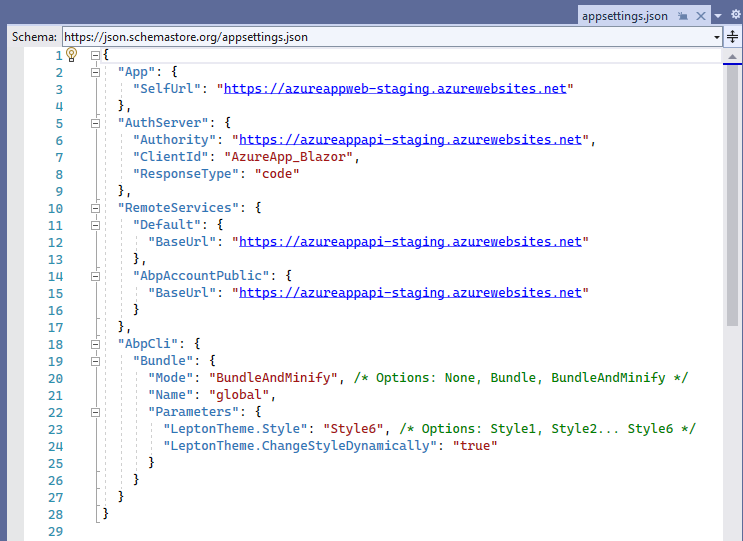
appsettings.json file for HttpApi.Host project is presented below containing the CorsOrigins and RedirectAllowedUrls containg the Blazor endpoint.
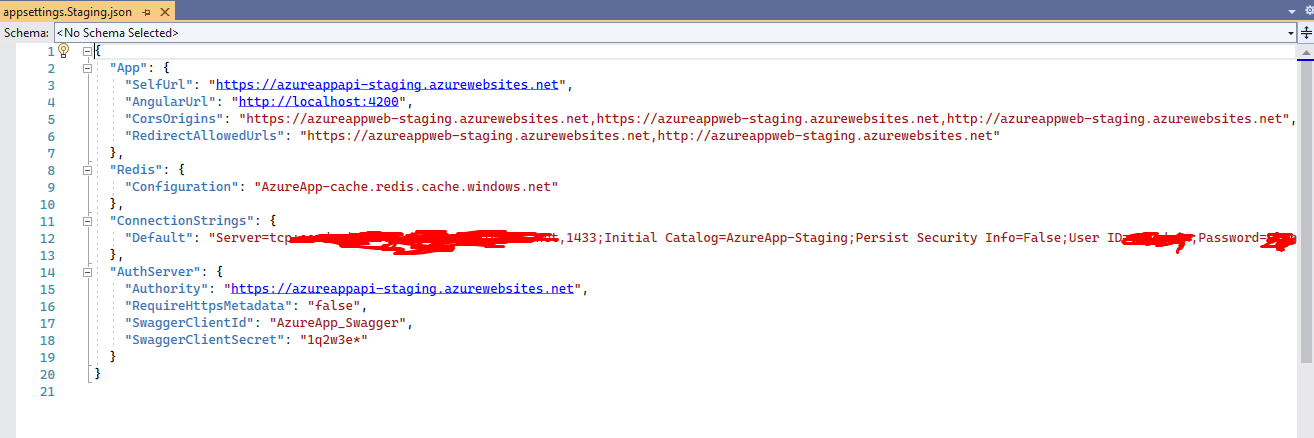
appsettings.json file for DbMigrator project is presented below, with the endpoints for Blazor and the API defined for the remote servers.
After the publish is done, the Swagger runs fine, so the API endpoint seems to be well configured as presented below:
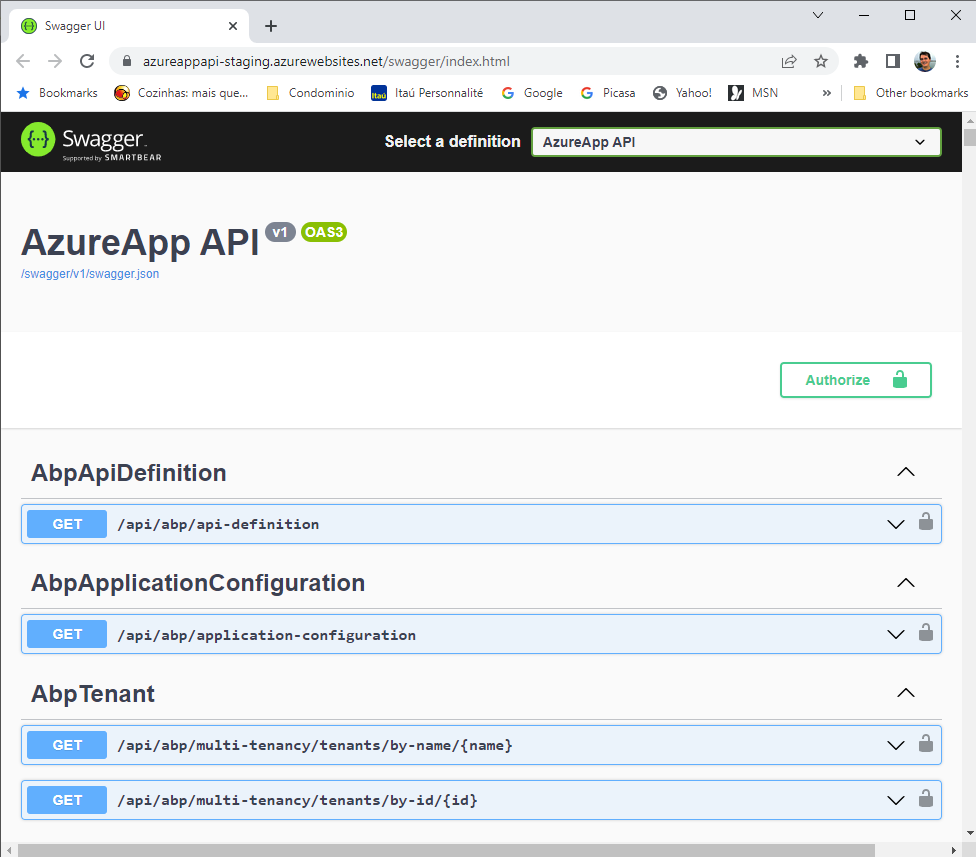
But the Blazor front end is loading endless as presented below:
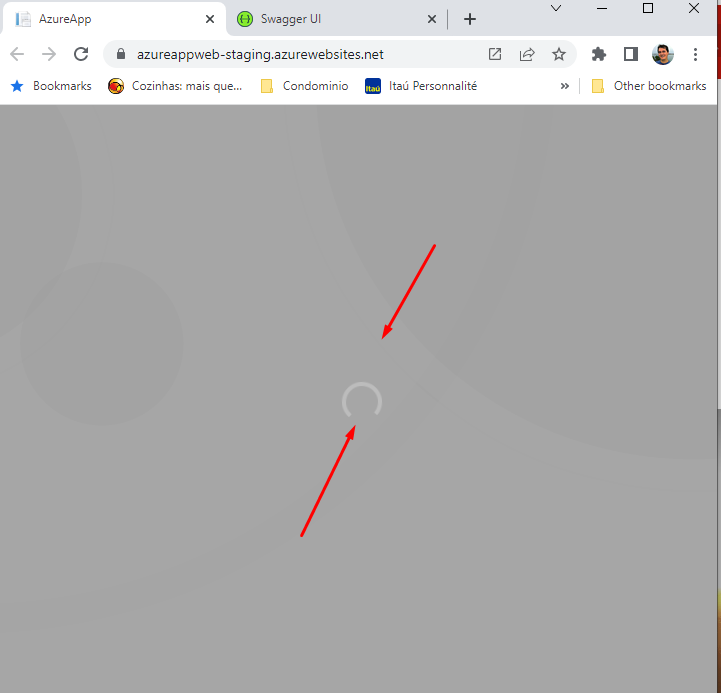
I´ve already rebuilt the application to avoid mistakes. I searched on the web, also on the ABP support and community and reviewed the settings. I found many other folks having the same issue reported in the support and comunity. I believe there is a trick that is missed by blog authors on community also in the answers from support tickets found.
Here is the symptons found using the "Dev tools" available in the Google Chrome browser:
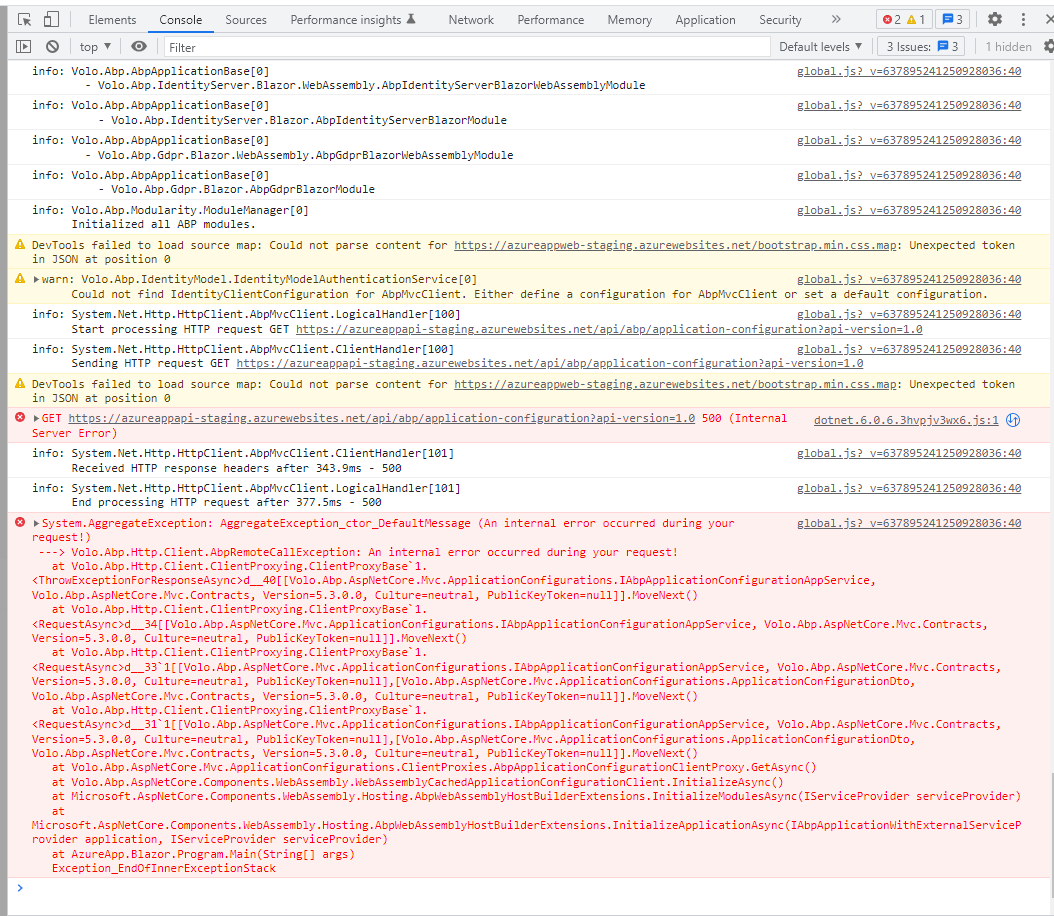
here is an additional information on the "network" available in the "Dev tools" presenting many failures:
Here is the check-point about the endpoint being pointed correctly by the Blazor app:
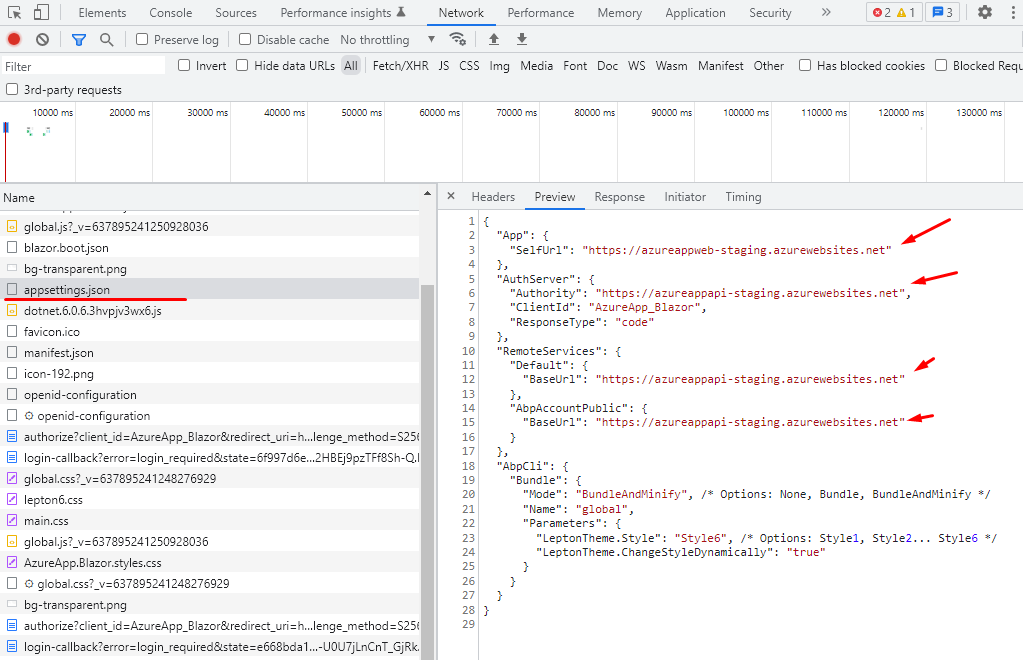
Here are the detailed screens that might be the problem:
Screen 1:
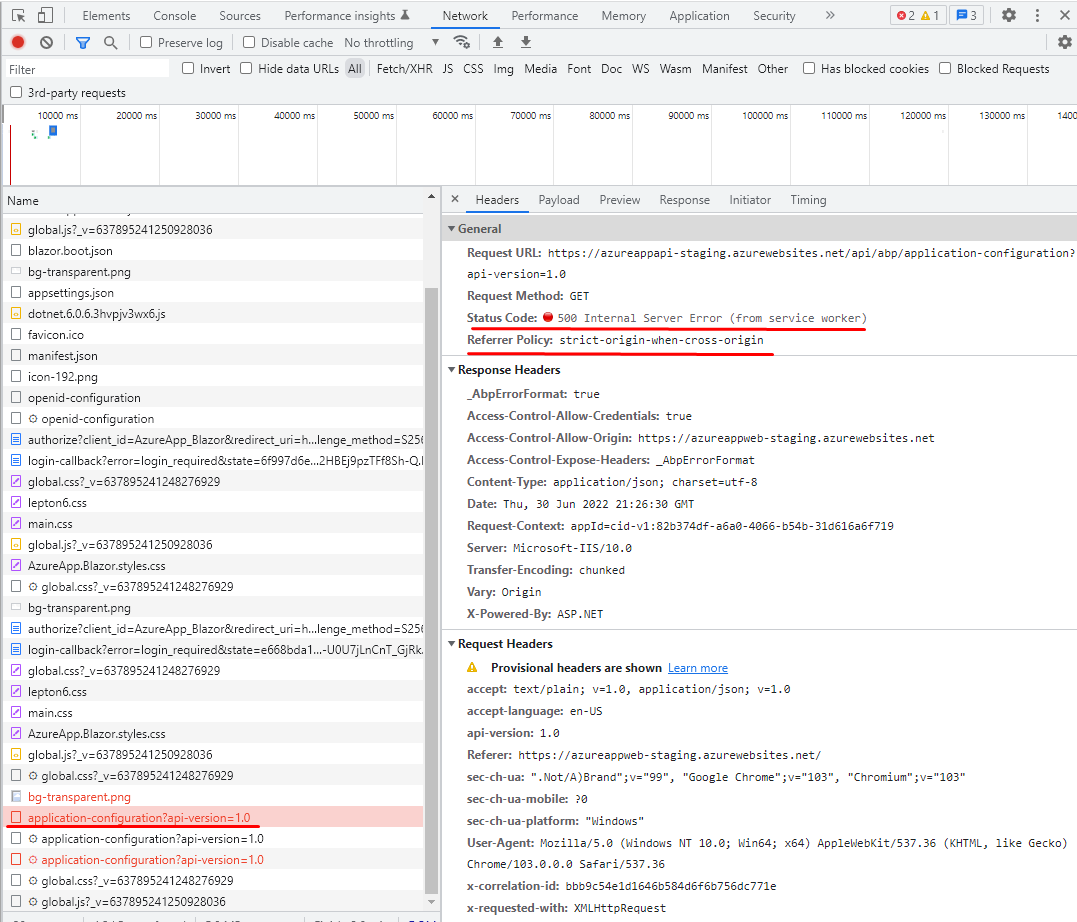
I´m really blocked for a long time trying to find a solution by myself but I was not able to find what is going wrong with the settings.
Please help on this! 😊
Best Regards,
Christian
<br> <br> <br>
Hi Folks, I´m returning with the setup of Azure Webapp service and I´m facing problem on Blazor endpoint. Here is a summary explanation about the environment: -> 1 Azure Webapp Service for the API (project {AppName}.HttpApi.Host) -> 1 Azure Webapp Service for the Blazor Wasm (project {AppName}.Blazor)
in both Azure Webapp Service instances, the ASPNETCORE_ENVIRONMENT configuration is defined to Staging.
In both projects the files aspsettings.Staging.json exist and have the recommended URL set for the public endpoints.
I believe that the ABP default template for Blazor UI need extra configuration to work correctly on Azure Webapp Service because in my local PC the application runs sucessfully but on the Web, the Blazor endpoint is still waiting for anything instead of load the home webpage.
I created this appliction to debug the Deployment on Azure Webapp Services, so the application doesn´t have any sensitive information and then I will present here the real scenario without restrictions.
Here below is the API running on a real URL: https://azureapp-api-staging.azurewebsites.net/swagger/index.html (project {AppName}.HttpApi.Host existing in the Solution created by ABP Suite)
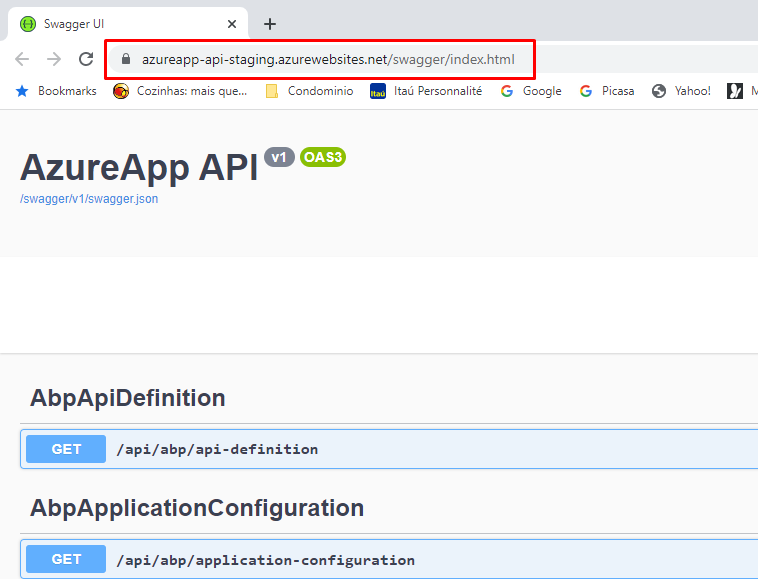 Here below is the aspsetting file content related to the API project {AppName}.HttpApi.Host poiting to Azure Webapp services
Here below is the aspsetting file content related to the API project {AppName}.HttpApi.Host poiting to Azure Webapp services
<br> The Blazor App is presented below. Here below is the WebApp running on a real URL: https://azureapp-web-staging.azurewebsites.net/ (project {AppName}.Blazor existing in the Solution created by ABP Suite)
Here below is the loaded information about the aspsettings file that was loaded in the Browser (the Blazor app). It was collected using the "Developer Tools" existing in Google Chrome browser. The same information appears when using MS Edge Browser.
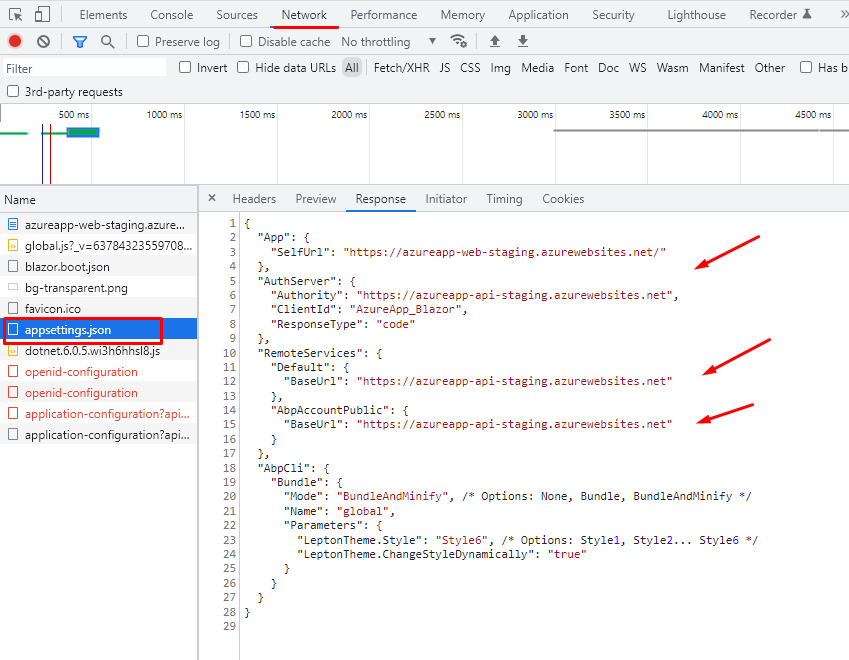
By this screen shot, it seems to be poiting to the correct API endpoint but the application does not load, the application keeps waiting for any answers indefinitely.
Please give help me to understand what need to be changed or fixed to have the ABP application deployed using Azure Webapp Services, because in the local PC the application is running fine.
Hi Folks,
I know that the file aspsetting.json can be customized for each environment and the connection string for each environment is already set as the picture below shows:
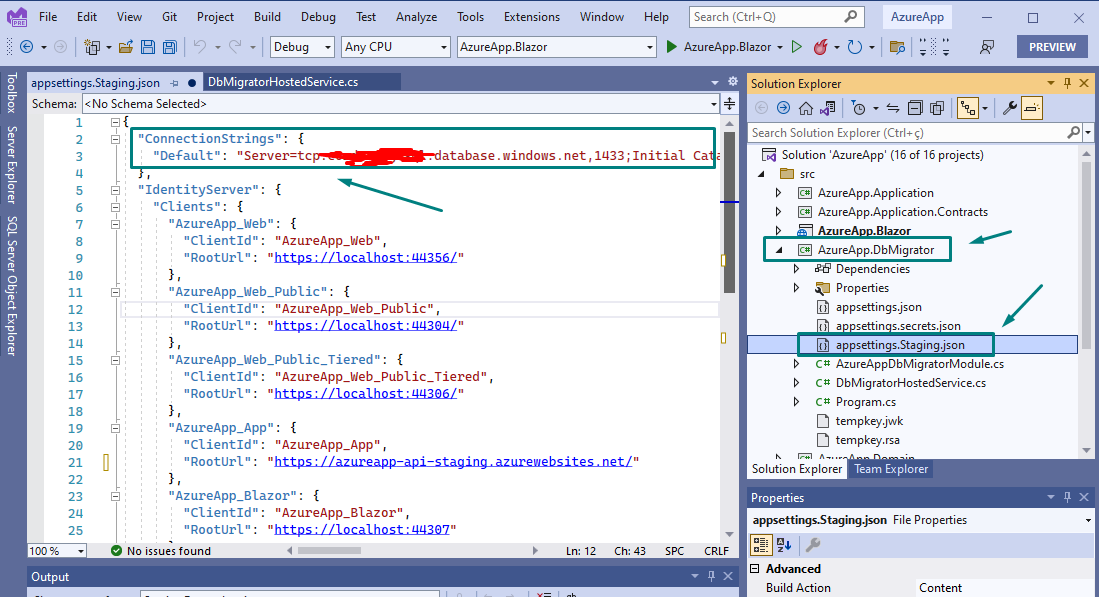
Similar aspsettings.json file can be prepared to development, production or any other environment. This is not the problem.
The question is: how to make make the WebApi implemented by "{appname}.HttpApi.Host" to understand that there is a migration pending and apply the migration to the Database once the new release is launched in the remote server? Is it possible to refer explain how to implement it? Or is there another strategy recommended by ABP.IO to deploy the application to multiples environments?
Check the docs before asking a question: https://docs.abp.io/en/commercial/latest/ Check the samples, to see the basic tasks: https://docs.abp.io/en/commercial/latest/samples/index The exact solution to your question may have been answered before, please use the search on the homepage.
If you're creating a bug/problem report, please include followings:
- ABP Framework version: v5.2.2
- UI type: Blazor
- ABP Suite: Yes
- ABP Suite Version: v5.2.2
- DB provider: EF Core
- Tiered (MVC) or Identity Server Separated (Angular): no
- Soution has Public Web Site project: Yes
- Exception message and stack trace:
- Steps to reproduce the issue:"
I created Solution containg a Blazor App, Web API ({appname}.HttpApi.Host) and Public Website using ABP Suite as shown by the picture below:
At this moment the solution was created with no additional entities. The solution containing multiples projects (Blazor App, Wep API, Public WebSite) was synchronized with Github repository, additionally it was created 3 branches named "Development", "Staging" and "Main" to allow 3 distinct environments for the software lifecycle.
We created the Microsoft Azure WebApps integrated with Github using the standard Azure wizard during the WebApp creation process (using the wizard), and just set manually the project path to the CSPROJ file in the YAML for each project. We created a "Azure Cache for Redis" service in Microsoft Azure to support the "Public Website" considering the documentation requirements to have Redis available for caching the Public Website. We created 3 distinct database instances using Azure SQL Server to support each of 3 environments.
The WebAPI is published on each AzureWebApp pointing to the right database instance.
How can we propagate the Database Migrations when we create or change any Entity using ABP Suite? In the Local Database at my PC where I´m running ABP Suite, the changes were applied automatically by ABP Suite. Once I sync with the remote repository and commit using Github to "Development" branch, the Github automation starts a new deployment to Azure WebApp instance but I could not find a way to apply the changes to remote database instance automatically, the only way I could do this migration was by running manually the project DbMigrator existing in my PC (using DOTNET RUN inside the DbMigrator folder) pointing to the remote Database Instance, applying the changes manually. How can I apply the migration/changes to the Database when the new release of the WebAPI is deployed and is required to update the database instance? Is there any solution embebed WebAPI project to verify the database instance and apply the migrations?
Best regards,
Christian
